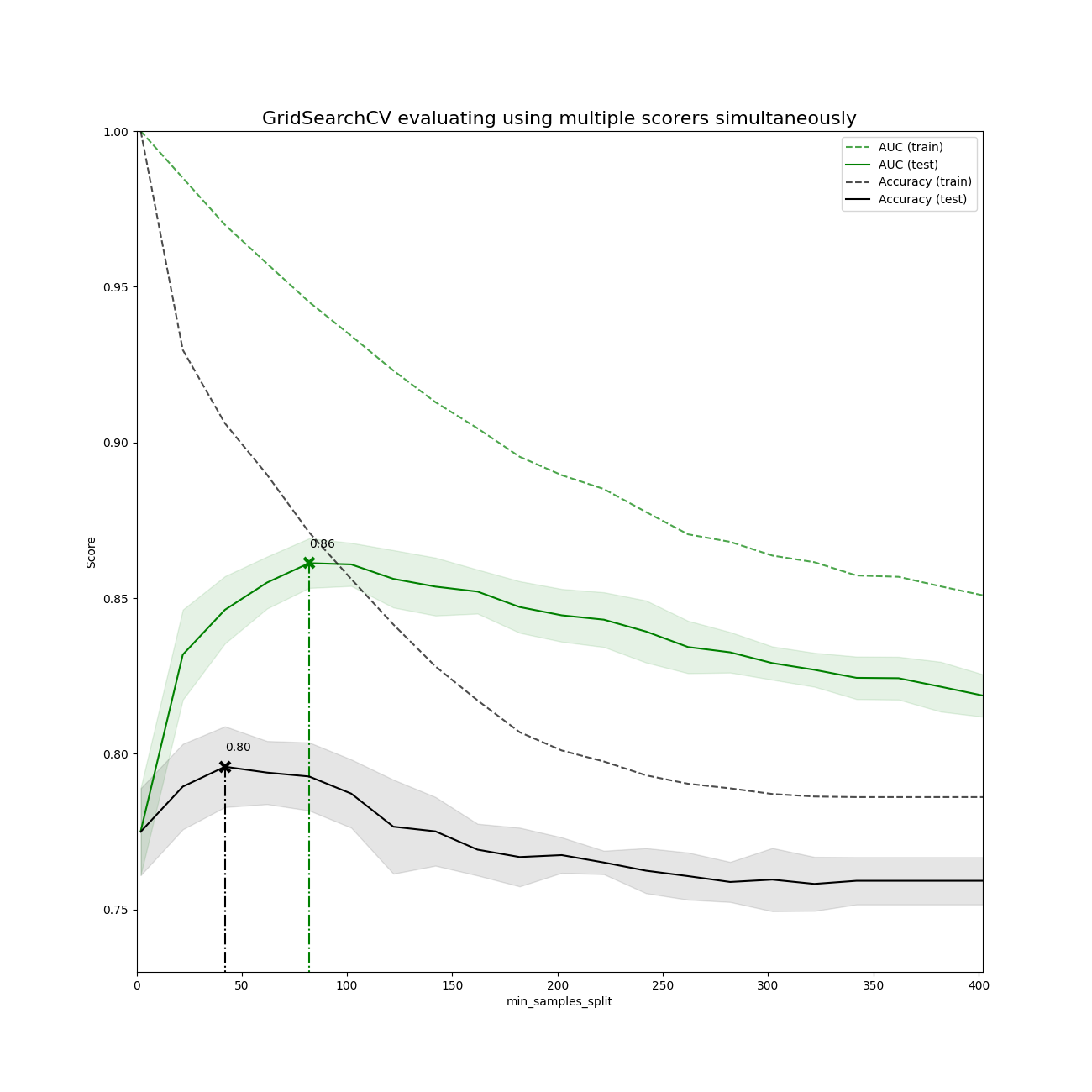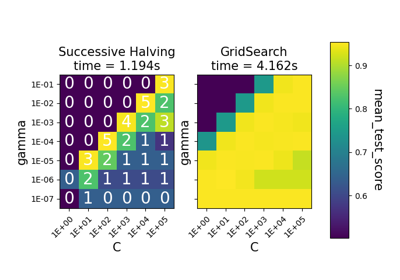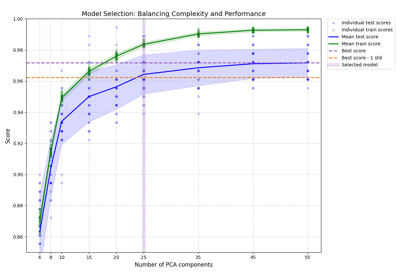备注
Go to the end 下载完整的示例代码。或者通过浏览器中的MysterLite或Binder运行此示例
基于cross_val_score和GridSearchCV的多度量评估演示#
可以通过设置 scoring 指标评分者名称列表或将评分者名称映射到评分者可调用的dict的参数。
The scores of all the scorers are available in the cv_results_ dict at keys
ending in '_<scorer_name>' ('mean_test_precision',
'rank_test_precision', etc...)
的 best_estimator_ , best_index_ , best_score_ 和 best_params_ 对应于设置为 refit 属性
# Authors: The scikit-learn developers
# SPDX-License-Identifier: BSD-3-Clause
import numpy as np
from matplotlib import pyplot as plt
from sklearn.datasets import make_hastie_10_2
from sklearn.metrics import accuracy_score, make_scorer
from sklearn.model_selection import GridSearchCV
from sklearn.tree import DecisionTreeClassifier
运行 GridSearchCV 使用多种评估指标#
X, y = make_hastie_10_2(n_samples=8000, random_state=42)
# The scorers can be either one of the predefined metric strings or a scorer
# callable, like the one returned by make_scorer
scoring = {"AUC": "roc_auc", "Accuracy": make_scorer(accuracy_score)}
# Setting refit='AUC', refits an estimator on the whole dataset with the
# parameter setting that has the best cross-validated AUC score.
# That estimator is made available at ``gs.best_estimator_`` along with
# parameters like ``gs.best_score_``, ``gs.best_params_`` and
# ``gs.best_index_``
gs = GridSearchCV(
DecisionTreeClassifier(random_state=42),
param_grid={"min_samples_split": range(2, 403, 20)},
scoring=scoring,
refit="AUC",
n_jobs=2,
return_train_score=True,
)
gs.fit(X, y)
results = gs.cv_results_
绘制结果#
plt.figure(figsize=(13, 13))
plt.title("GridSearchCV evaluating using multiple scorers simultaneously", fontsize=16)
plt.xlabel("min_samples_split")
plt.ylabel("Score")
ax = plt.gca()
ax.set_xlim(0, 402)
ax.set_ylim(0.73, 1)
# Get the regular numpy array from the MaskedArray
X_axis = np.array(results["param_min_samples_split"].data, dtype=float)
for scorer, color in zip(sorted(scoring), ["g", "k"]):
for sample, style in (("train", "--"), ("test", "-")):
sample_score_mean = results["mean_%s_%s" % (sample, scorer)]
sample_score_std = results["std_%s_%s" % (sample, scorer)]
ax.fill_between(
X_axis,
sample_score_mean - sample_score_std,
sample_score_mean + sample_score_std,
alpha=0.1 if sample == "test" else 0,
color=color,
)
ax.plot(
X_axis,
sample_score_mean,
style,
color=color,
alpha=1 if sample == "test" else 0.7,
label="%s (%s)" % (scorer, sample),
)
best_index = np.nonzero(results["rank_test_%s" % scorer] == 1)[0][0]
best_score = results["mean_test_%s" % scorer][best_index]
# Plot a dotted vertical line at the best score for that scorer marked by x
ax.plot(
[
X_axis[best_index],
]
* 2,
[0, best_score],
linestyle="-.",
color=color,
marker="x",
markeredgewidth=3,
ms=8,
)
# Annotate the best score for that scorer
ax.annotate("%0.2f" % best_score, (X_axis[best_index], best_score + 0.005))
plt.legend(loc="best")
plt.grid(False)
plt.show()

Total running time of the script: (0分9.658秒)
相关实例
Gallery generated by Sphinx-Gallery <https://sphinx-gallery.github.io> _




